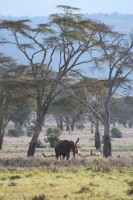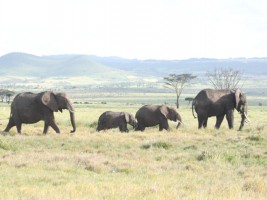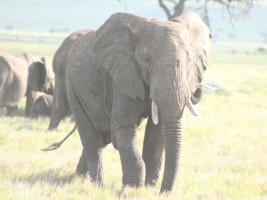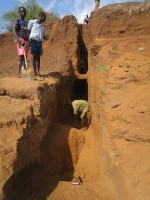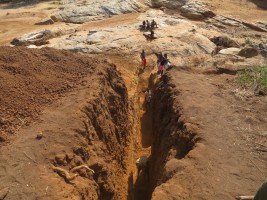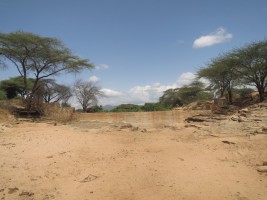Protecting elephants with sand dams

This project takes place in Lekurruki, a community-owned conservancy in the North of Laikipia County, where 69% of individuals has no access to safe water. The population is estimated to 3,126 people, with 19,072 livestocks (including piglets, cattle, donkeys and camels). This region also suffers from increasing drought forcing people and wildlife, especially elephants, to travel far in search of water, and often come into conflict at dwindling water sources.
At the same time, Lekurruki Conservation Trust (LCT) witnessed a significant reduction in number of elephants in this region. Wildlife species observation data found the number of elephants recorded by rangers declining by 77% over two years, from 7,575 in 2013, to 1,725 in 2015. This decrease is mainly due to Humans/Elephants conflicts over water, and elephants moving to new areas in search of water sources. There is no known poaching in the area.
The project will increase access to safe water and help reduce human-wildlife conflicts through building sand dams- a low-cost, multi-use rainwater harvesting solution built in seasonal riverbeds. A sand dam is a reinforced concrete wall built in a seasonal riverbed during the dry season. During the rainy seasons, it retains water and sand behind the dam wall and can naturally store up to 40 million liters of water every rainy season. By storing water safely within sand, it is protected from evaporation, contamination and disease. Sand dams are a perfect water source for elephants, who are well known for digging for water from sandy riverbeds – just like many rural dryland people. And, just like people, they prefer water found this way to open water holes because it is clean. Moreover, separating water abstraction points for people from those for animals will further reduce incidences of human/wildlife conflicts; ultimately protecting threatened wildlife such as elephants.
Also, with a water source close to people’s homes, sand dams save people time and create opportunity. With a year round water source for agriculture and livestock, communities can invest more time in their farming- improving crop and food production for people and animals.
Finally, as sand dams raise the water table, in the area both above and below the dam, this will help mitigate desertification and the impact of climate change. In effect, this creates a ‘permanent spring’, keeping more water in the area. Vegetation regenerates on river banks. Erosion is reduced and soil quality improves, helped by terracing. Less than 3% of water flowing is captured by the dams, so water is not diverted away from downstream users.
Different activities are planned to reach the overall objective:
- This project will include the construction of one sand dam. A fundamental part of the project is that communities invest their own time and labor to collect local materials and build the dam themselves.
- Capacity building of LCT: LCT will learn the technical skills to site, design and construct sand dams, through the experience and support from Africa Sand Dam Foundation (ASDF). Capacity building will include water resource management training, developing monitoring and evaluation as well as training in scenario planning to facilitate strategic thinking- i.e. how to avoid human/human and human/wildlife conflict over water sources. Ultimately this will help create a scalable replicable model to implement across more community conservancies in the Northern Rangelands (the region where the project takes place).
- Abstraction methods to access water: The sand dam will have a shallow well for protected water abstraction for people and a separate drinking trough for animals.
- Wildlife indicators: This project will incorporate wildlife counts to monitor the numbers of species in the Conservancy and will explore the development of monitoring beyond wildlife indicators.
Final summary report (November 2017):
Over the funded period, various activities have been done:
- The sand dam has been built.
- 50 people, members of local communities worked every days on the site. They also provided a part of the materials.
- Elephants and zebras observations have increased of 28% and 31% respectively.
- A technical support has been brought to the local partner, Lekurruki Conservation Trust, in the location choice, in the conception and in the construction.
- The water quality tested shown it fulfilled the WHO requirement.
Check out the Lekineji Moile and Ltiriyon Lelemoyog testimony, both beneficiairies of the project.
Find out more on this project in this report.







